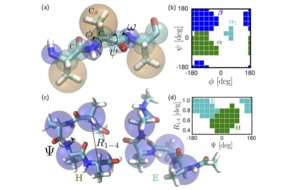Joseph F. Rudzinski and Tristan Bereau, Eur. Phys. J. Spec. Top. (2016)
Improve coarse-grained model by optimizing both its statics and kinetics
The parametrization of coarse-grained (CG) simulation models for molecular systems often aims at reproducing static properties alone. The reduced molecular friction of the CG representation usually results in faster, albeit inconsistent, dynamics. In this work, we rely on Markov state models to simultaneously characterize the static and kinetic properties of two CG peptide force fields—one top-down and one bottom-up. Instead of a rigorous evolution of CG dynamics (e.g., using a generalized Langevin equation), we attempt to improve the description of kinetics by simply altering the existing CG models, which employ standard Langevin dynamics. By varying masses and relevant force-field parameters, we can improve the timescale separation of the slow kinetic processes, achieve a more consistent ratio of mean-first-passage times between metastable states, and refine the relative free-energies between these states. Importantly, we show that the incorporation of kinetic information into a structure-based parametrization improves the description of the helix-coil transition sampled by a minimal CG model. While structure-based models understabilize the helical state, kinetic constraints help identify CG models that improve the ratio of forward/backward timescales by effectively hindering the sampling of spurious conformational intermediate states.

